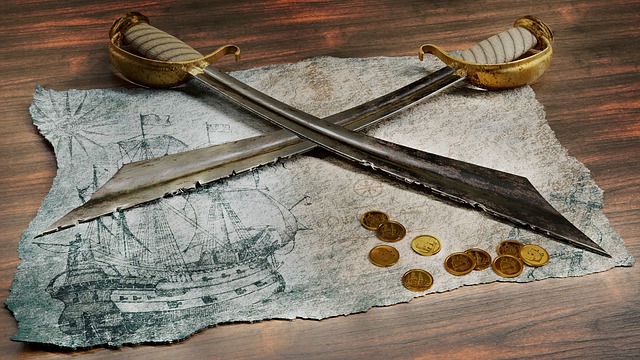By Tim Lambert
A pirate is a person who robs ships. The idea is not new! There have been pirates since ancient times. After 800 BC a people called the Phoenicians from what is now Lebanon had many merchant ships carrying valuable cargoes across the Mediterranean. As they sailed near the Adriatic Sea and the Aegean Sea pirates sailed after them and robbed them.
In the 1st century BC pirates were a serious menace in the Mediterranean. Pirates captured Julius Caesar when he was a young man. Finally, in 67 BC the Roman Senate decided to take action. They appointed Pompey to deal with them. He divided the Mediterranean into sections. Pompey quickly defeated the pirates and thousands were killed. Many more surrendered and hundreds of pirate ships were captured.
The next great period of piracy was the Middle Ages. In the 12th and 13th centuries trade in Europe was growing rapidly offering rich pickings for pirates. The English Channel was infested with pirates many of them operating from the Cinque Ports, Dover, Hastings, Hythe, Romney, and Sandwich. There were also pirates operating from ports like Dunkirk and Calais. There were also many pirates in the Indian Ocean and the Mediterranean.
During the Middle Ages there were many pirates in the Mediterranean. In the 16th and 17th centuries, pirates in North Africa flourished even sailing into the Atlantic. They were sometimes known as Barbary Corsairs. In 1803 the USA sent a fleet to Tunis against the pirates but the Barbary Corsairs were only finally defeated in 1820 when the French sent a large fleet to Algiers and Tunis.
Meanwhile, pirates continued to sail on the English Channel. However, in the mid-17th century Oliver Cromwell built up a formidable navy and by 1651 the pirates had been driven from their bases in the Sicily Isles and the Channel Islands.
Furthermore the discovery of the New World led to a new golden age of piracy. The Spanish conquered the Aztecs and the Incas. They created a rich empire in Central America and ships laden with gold sailed back to Spain. They provided rich pickings for pirates, including many English pirates. (Both John Hawkins and Francis Drake were pirates).
In the 17th century French pirates sailed into the Caribbean and preyed on the Spanish. The pirate’s dried meat on a grill called a barbecu. The meat was called boucan and the men who ate it were called boucaniers or buccaneers. As well as the French there were English, Dutch, and Portuguese buccaneers. By the late 17th century buccaneers of many different nationalities served under ‘admirals’.
As well as the buccaneers there were privateers. In wartime, governments authorized captains to capture enemy merchant ships and loot them. One famous privateer was Captain William Kidd. However, Kidd was accused of overstepping the mark into outright piracy and he was hanged in 1701. Another famous privateer was the Welshman Sir Henry Morgan (c 1635-1688) who was knighted in 1674 and was appointed lieutenant-governor of Jamaica (a British colony). However, in 1856 most European nations signed a declaration of Paris making privateers illegal.
Pirate ships were armed with cannons and long-range guns called culverins. When they boarded ships pirates threw grenades. They also fought with muskets, pistols and the cutlass.

However, the British navy played a key role in ending piracy and the golden age of pirates came to an end in the 18th century. Among the most notorious pirates was Edward Teach, known as Blackbeard, who was killed in 1718. Not all pirates were men. There were also many women pirates. Among the most notorious women pirates were Anne Bonny and Mary Read. Perhaps the most fearsome female pirate was a Chinese woman called Ching Shih. She rose to command a great fleet of pirate ships.
Yet off China and Southeast Asia piracy continued through the 19th century and the 20th century. In the early 21st century many pirates operate from Somalia. In 2008 they stole a Ukrainian ship carrying 33 tanks. They also hijacked an oil tanker.
Last revised 2024